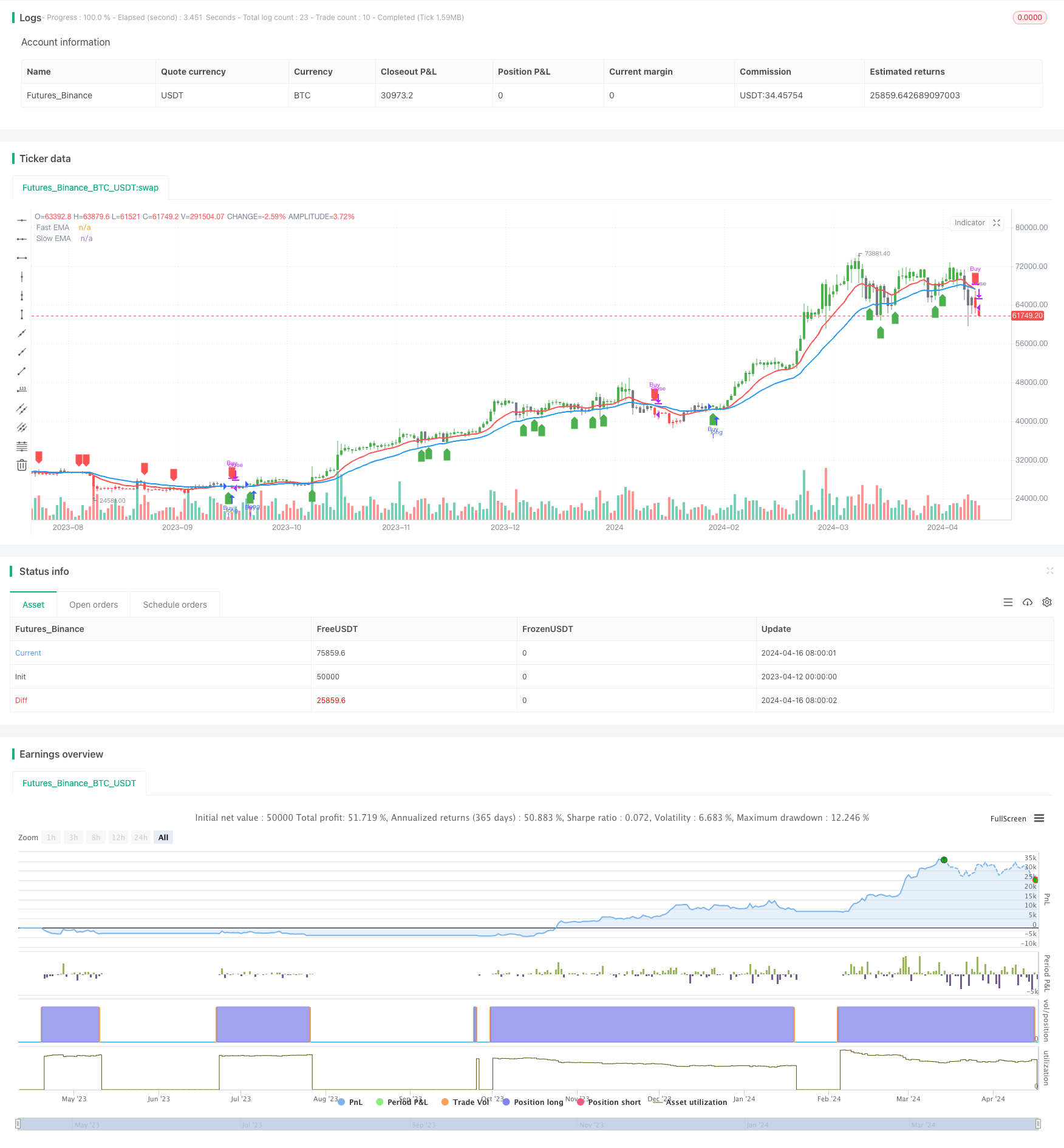
概述
该策略使用两条不同周期的指数移动平均线(EMA)进行交叉,当快速EMA从下往上穿越慢速EMA时产生买入信号,当快速EMA从上往下穿越慢速EMA时产生卖出信号。该策略可以应用于各种金融工具和时间周期,例如黄金在2小时周期上最有效,比特币在日线图上最有效等。
策略原理
- 计算快速EMA(默认周期为12)和慢速EMA(默认周期为26)。
- 定义多头区域(快速EMA在慢速EMA上方且价格在快速EMA上方)和空头区域(快速EMA在慢速EMA下方且价格在快速EMA下方)。
- 当从空头区域转换为多头区域时买入,当从多头区域转换为空头区域时卖出。
- 在图表上用绿色和红色标记多头区域和空头区域,用箭头标记买卖信号。
策略优势
- 简单易懂,适合初学者学习。
- 适用性广,可以用于各种金融工具和时间周期。
- 趋势跟踪能力强,能够捕捉到中长期趋势。
- 参数可调,增加了灵活性。
策略风险
- 在震荡市容易产生错误信号,导致亏损。
- 趋势转折时反应较慢,会造成一定滑点。
- 参数选择不当会影响策略效果。
策略优化方向
- 加入趋势过滤,比如只在ADX大于某个值时交易,减少震荡市的亏损。
- 优化进出场时机,比如使用ATR决定止损止盈,减少单笔亏损。
- 对参数进行优化,找到最佳参数组合,提高稳定性和盈利能力。
- 结合其他指标辅助判断,如MACD、RSI等,提高信号准确率。
总结
MACD交叉策略是一个基于趋势跟踪的简单策略,优点是简单实用、适用范围广,缺点是难以把握趋势转折、参数选择有难度。通过趋势过滤、优化进出场点、参数优选和组合其他指标可以改进该策略的表现,值得进一步研究和测试。
策略源码
/*backtest
start: 2023-04-12 00:00:00
end: 2024-04-17 00:00:00
period: 1d
basePeriod: 1h
exchanges: [{"eid":"Futures_Binance","currency":"BTC_USDT"}]
*/
//@version=5
strategy('Advance EMA Crossover Strategy', overlay=true, precision=6)
//****************************************************************************//
// CDC Action Zone is based on a simple EMA crossover
// between [default] EMA12 and EMA26
// The zones are defined by the relative position of
// price in relation to the two EMA lines
// Different zones can be use to activate / deactivate
// other trading strategies
// The strategy can also be used on its own with
// acceptable results, buy on the first green candle
// and sell on the first red candle
//****************************************************************************//
// Define User Input Variables
xsrc = input(title='Source Data', defval=close)
xprd1 = input(title='Fast EMA period', defval=12)
xprd2 = input(title='Slow EMA period', defval=26)
xsmooth = input(title='Smoothing period (1 = no smoothing)', defval=1)
fillSW = input(title='Paint Bar Colors', defval=true)
fastSW = input(title='Show fast moving average line', defval=true)
slowSW = input(title='Show slow moving average line', defval=true)
plotSigsw = input(title='Plot Buy/Sell Signals?', defval=true)
//****************************************************************************//
//Calculate Indicators
xPrice = ta.ema(xsrc, xsmooth)
FastMA = ta.ema(xPrice, xprd1)
SlowMA = ta.ema(xPrice, xprd2)
//****************************************************************************//
// Define Color Zones and Conditions
BullZone = FastMA > SlowMA and xPrice > FastMA // Bullish Zone
BearZone = FastMA < SlowMA and xPrice < FastMA // Bearish Zone
//****************************************************************************//
// Strategy Entry and Exit Conditions
if (BullZone and not BullZone[1])
strategy.entry("Buy", strategy.long) // Buy on the transition into BullZone
if (BearZone and not BearZone[1])
strategy.close("Buy") // Sell on the transition into BearZone
//****************************************************************************//
// Display color on chart
plotcolor = BullZone ? color.green : BearZone ? color.red : color.gray
barcolor(color=fillSW ? plotcolor : na)
//****************************************************************************//
// Plot Fast and Slow Moving Averages
plot(fastSW ? FastMA : na, color=color.red, title="Fast EMA", linewidth=2)
plot(slowSW ? SlowMA : na, color=color.blue, title="Slow EMA", linewidth=2)
//****************************************************************************//
// Plot Buy and Sell Signals
plotshape(series=plotSigsw and BullZone and not BullZone[1], location=location.belowbar, color=color.green, style=shape.labelup, title="Buy Signal")
plotshape(series=plotSigsw and BearZone and not BearZone[1], location=location.abovebar, color=color.red, style=shape.labeldown, title="Sell Signal")
//****************************************************************************//
相关推荐